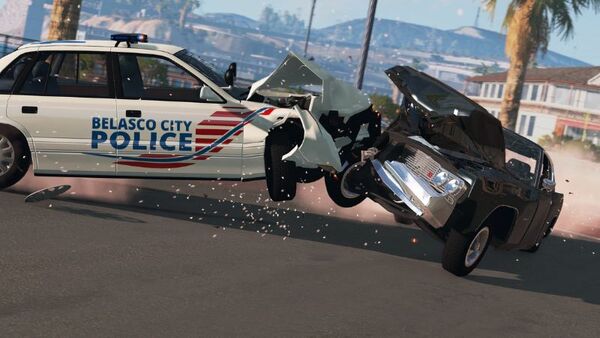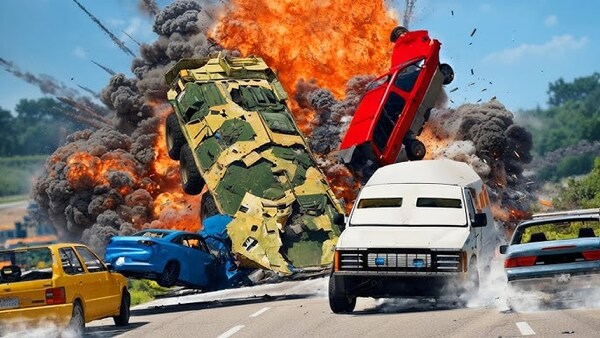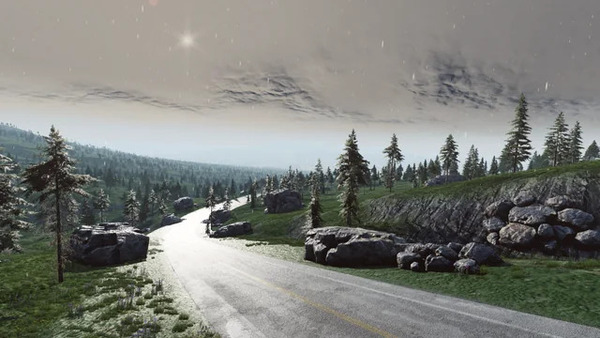Introduction
BeamNG.drive has gained significant attention in the gaming community for its remarkably realistic crash physics and vehicle damage simulation. The game’s unique soft-body physics engine allows players to witness detailed vehicle deformations, making every collision feel authentic. However, with this level of realism, players face challenges related to managing, understanding, and utilizing these physics to enhance their gameplay. This article delves deeply into the specific issue of advanced crash physics in BeamNG.drive, examining how vehicle deformation impacts gameplay and offering tips to navigate and leverage these mechanics.
- Understanding BeamNG.drive’s Soft-Body Physics Engine
BeamNG.drive’s soft-body physics engine forms the backbone of its realistic crash mechanics, offering players a lifelike collision experience that simulates real-world physics.

BeamNG.drive’s soft-body physics engine forms the backbone of its realistic crash mechanics
How Soft-Body Physics Differ from Traditional Mechanics
Traditional game engines use hard-body physics that often lack detail in deformation. In contrast, BeamNG’s soft-body approach allows each part of the vehicle to respond independently, creating lifelike damage.
Simulating Realistic Crashes and Impacts
In BeamNG.drive, every collision involves detailed calculations that simulate stress points and deformations, allowing players to experience how a vehicle’s structure realistically absorbs impacts.
- Vehicle Deformation: Effects on Gameplay and Handling
Vehicle deformation in BeamNG.drive impacts not only visuals but also gameplay mechanics, altering a vehicle’s handling, stability, and overall performance after a crash.
Immediate Impact on Steering and Control
After a severe collision, players will notice impaired steering or reduced control. Bent frames or damaged axles can lead to challenging driving conditions, forcing players to adapt.
Long-Term Effects on Vehicle Integrity
Repeated crashes can gradually weaken a vehicle’s structure, impacting its ability to absorb future collisions. This degradation mimics real-world wear and tear, demanding careful driving.
- Analyzing Frame Damage and Its Consequences
The frame of a vehicle in BeamNG.drive acts as the core structure, and significant frame damage can render the vehicle nearly undrivable. Understanding frame integrity is key to avoiding total loss.
Signs of Frame Damage in Gameplay
Signs of frame damage include misaligned wheels, sagging suspension, and a general reduction in structural integrity, all affecting vehicle stability.
Consequences of Ignoring Frame Integrity
Players who ignore frame damage will find their vehicle increasingly difficult to control, especially at high speeds. Persistent frame issues can lead to catastrophic failures during intense gameplay.
- The Role of Suspension Damage in Crash Physics
Suspension is a critical component affected by BeamNG.drive’s crash physics, with impacts to the suspension drastically changing vehicle handling on all terrains.
Understanding Suspension Breakage and Rebound
When the suspension system is damaged, players may experience erratic bouncing or an inability to maintain traction, particularly on rough surfaces.
Compensating for Suspension Damage
Adjusting driving speed and avoiding high-impact areas can help players manage suspension issues temporarily. However, repeated damage may require a vehicle reset.

Adjusting driving speed and avoiding high-impact areas can help players manage suspension issues temporarily
- Tire Deformation: Managing Traction and Stability
BeamNG.drive’s physics also simulate tire deformation under stress. A hard crash can lead to deflated or warped tires, affecting traction and stability.
Recognizing Tire Deformation Symptoms
Warped tires cause wobbling and uneven traction, making it difficult to maintain a straight path. Observing these signs early can help avoid losing control at higher speeds.
Temporary Solutions for Tire Issues
Slowing down and making controlled turns can help mitigate tire issues. However, players may need to replace or reset their vehicle for optimal performance.
- Using BeamNG.drive’s Damage Visualization Tools
BeamNG.drive provides players with visual aids to understand the extent of damage sustained during collisions, allowing for better management and repair.
The Damage Visualization Panel
The Damage Visualization Panel highlights impacted areas on a vehicle, helping players identify which parts require attention to regain control or functionality.
Leveraging Data for In-Game Adjustments
Using this panel, players can make informed choices about how to drive with damaged parts. For example, adjusting speed or taking a smoother route can prevent further damage.
- Modifying Crash Parameters: Experimenting with Physics
BeamNG.drive allows players to customize crash parameters and physics settings, enhancing their understanding of vehicle behavior and crash responses.
Adjusting Crash Intensity and Environmental Factors
Players can alter the force of impact, gravity settings, or material density to see how each adjustment affects vehicle deformation, giving insight into physics-based gameplay.
Testing Customized Parameters in Free Roam Mode
Using Free Roam mode, players can test various crash scenarios with modified parameters to refine their control and response skills in different crash settings.
- Repairing Vehicles Mid-Game: Strategies for Extended Gameplay
BeamNG.drive enables players to repair or reset their vehicles, which is essential after sustaining significant damage in high-impact collisions.
When to Opt for Full Vehicle Reset
Full resets are best for extreme damage cases where frame integrity is compromised. A reset restores the vehicle but can interrupt the gameplay flow.

Full resets are best for extreme damage cases where frame integrity is compromised
Partial Repairs for Moderate Damage
For minor issues like tire deformation or suspension damage, partial repairs or adjustments can keep the gameplay immersive without fully resetting progress.
- Strategies for Minimizing Damage During Intense Collisions
While BeamNG.drive is designed for realistic crashes, there are ways to minimize damage and maintain control, even in high-speed situations.
Using Brakes and Steering to Absorb Impact
By braking before impact or steering at an angle, players can reduce the direct force of a collision, helping to prevent severe vehicle deformation.
Choosing Safer Routes on Rough Terrain
Selecting paths with fewer obstacles minimizes the risk of hitting hard surfaces, which helps preserve vehicle condition in rugged environments.
- Advanced Tips for Leveraging Crash Physics in Scenarios
Players can harness BeamNG.drive’s crash physics for skill-building in specific scenarios like stunt driving, police chases, and obstacle navigation.
Practicing Controlled Crashes in Stunt Mode
Stunt mode allows players to experiment with controlled crashes, learning how to manage vehicle deformation while still maintaining some degree of control.
Navigating Obstacle Courses with Minimal Damage
In obstacle courses, careful navigation and speed control allow players to complete challenges with limited damage, honing their skills in BeamNG.drive’s unique crash dynamics.
Conclusion
BeamNG.drive’s advanced crash physics offer an unparalleled level of realism in vehicle simulation, making it both challenging and rewarding for players interested in realistic vehicle deformation and damage management. By understanding and leveraging the game’s physics engine, players can enjoy a deeper, more strategic approach to gameplay, learning to handle each collision’s consequences while enhancing their driving skills. From mastering suspension damage to using in-game repair strategies, BeamNG.drive’s crash physics are central to the game’s appeal and an essential skillset for avid players.


